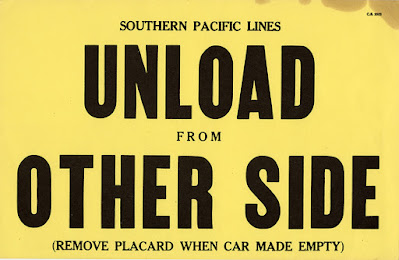I have written blog posts about quite a few items of prototype paperwork, both about waybills and associated documents used in the movement of freight, and operating documents such as train orders. In the present post, I want to show a few more, which could readily be adapted for model use if desired. Three of the documents I show today are from the collection of Michael Litant, whose generosity in sharing these is appreciated.
First is an interesting form, used in the movement of oversize loads which might require idler cars. It’s a Boston & Maine document and is 4.25 x 9.5 inches in size, barely fitting on a route card board and perhaps more likely on a placard board. It documents a New York Central gondola, NYC 726484, a 65-foot car with a steel floor, with a load of plate steel, 104 feet, 10 inches long. This meant that an idler car was used at each end, B&M 34015 on the east end, and EJ&E 6545 on the west end. Both were 53 ft., 6 inch flat cars. As the form shows, the overhang at each end of the gondola was approximately equal, about 24 feet in each case.
Note in the above form (you can click on the image to enlarge it) that the corporation is shown as “debtor,” and the trustee, Robert W. Meserve, is named. The B&M declared bankruptcy in 1970; the form is dated May 25, 1975.
I have shown several times examples of prototype Empty Car Bills, and here is yet another example, this one from the New Haven. Though not filled out, it evidently originated at the Roxbury, Mass. yard, as it is so stamped. It is 4 x 9.25 inches in size. Like many such Bills, it can be used to move an empty car to where it is to be loaded, or can move an unneeded empty car homeward. Interestingly, space is including in this bill for grading of the interior condition of the car.
I recently was given this familiar placard, seen on many railroads though often on manila rather than yellow card stock. Since it reads “Southern Pacific Lines,” it is likely from before 1946, when SP changed both its car lettering, and most company documents, to remove the word “Lines.” Soon after 1946, most such documents began to labeled “Southern Pacific Company.” It is 7 x 11 inches.
Another Litant item, that is more of an operating detail document, is a classic “train delay” form, used on many railroads to report, as it says at the top, “Extra Time Claimed by Conductors and Trainmen for Switching, Terminal Delays and other Arbitraries.” It’s a New Haven document and is dated March 14, 1963, and was deposited at the Readville, Mass. freight agent by J.E. Bergeron, conductor, along with two brakemen, J.J. Morrisseey and J. Beale. It’s 5.5 x 11 inches.
What’s interesting here is the reason for delay (one hour claimed). It reads, “Assisted wrecking crew to re-rail car # TNO 60790 [a 40-ft. steel box car] which was derailed by consignee at Norwood St. house while barring cars down.” Likely “barring” refers to using a pry bar or crowbar to move a car, by prying under the wheel and lifting. One of the classic aspects of this document is that I’ve heard more than one conductor talk about documenting delays, and saying “we filed a green sheet,” or “we grabbed a greenie right away.”
Asking a crew on a model railroad to fill out a “green sheet” would be a little idle, as we are rarely paid for our operations. But the oversize-load document could well be included along with other normal waybills as part of a train. Regarding this particular oversize-load document, presumably the load in the NYC gondola had its own waybill, but this kind of document could be supplied also.
I continue to enjoy coming across prototype documents like these. Not only are they interesting as railroad artifacts, they are glimpses into operating procedures, and in many cases could certainly be adapted for model use.
Tony Thompson




No comments:
Post a Comment